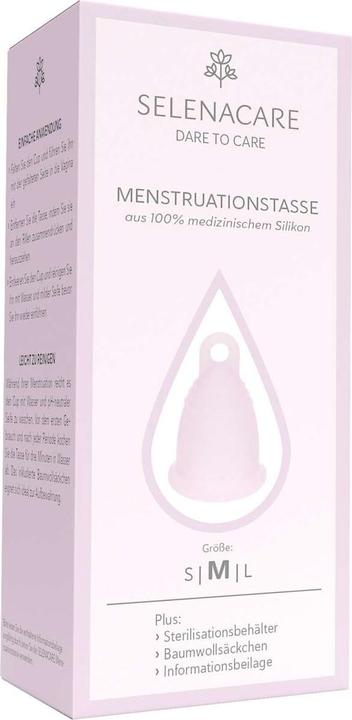

Why I’m still using my menstrual cup despite some bloody mishaps
People who menstruate don’t have it easy. It’s not only my actual period that occasionally has my womb praying for relief – it’s also my menstrual cup. Here’s why I’ve continued using it nonetheless.
CAUTION: This article contains bloody references. If you can’t handle that, you’d better not read on.
Toiletries aisle, feminine hygiene section. Maybe you know the feeling – that feeling of being spoilt for choice when it comes to period products. Two years ago, with sustainability becoming increasingly relevant in my life and a guilty conscience nagging away at me, I switched from tampons to menstrual cups. And I’ve got to admit, the transition hasn’t always been a roaring success. Having used it for around 24 cycles, I’ve certainly had one or two bloody mishaps. So here’s a personal highlights list of menstrual cup miseries, as well as the reason why cups are still worth using.
Top 3 bloody blunders
Admittedly, I can chalk up some of these fails to my own clumsiness. One time, the slippery cup simply slid out of my hand after I pulled it out, splattering the contents across the floor and the wall opposite. On another day, it fell right down the toilet. The consequence? A serious amount of wiping, followed by a chilly diving session for my hand that got me better acquainted with my loo than I would’ve liked.
The next calamity even claimed an innocent victim – my date. While I was in the bathroom, my gentleman caller had wandered into the kitchen unsupervised and helped himself to a cup of tea. The white mug he’d used to prepare it had a special function; it’s the cup I only ever use for soaking my menstrual cup in boiling water after use. Just as I came back into the kitchen, my date was taking his first sip, completely none the wiser. He wasn’t the only one who gulped. For a split second, I considered knocking the tea out of his hand in the style of a theatrical poisoning scene, but I refrained. I didn’t say anything either, because, frankly, I was too embarrassed to explain what the true purpose of the cup was. I soothed my guilty conscience with the thought that it had, of course, been rinsed clean beforehand.
And the unnecessary icing on the cake of my past misery? As I was taking out the cup, the stem designed to help do this, tore clean off.

Source: Maike Jensen
I sat there in mild bewilderment, the stem in my hand, the cup (still) inside my vagina. The subsequent on-the-scene rescue effort was, as expected, bloody. When I emerged from the bathroom, I felt like the doctors in Grey’s Anatomy when they burst out of the OR after a difficult surgery, angry and utterly demoralised. In moments like these, I treat myself to tampons as a sort of breather. They are, after all, easier to handle.
A storm in a (menstrual) cup? Period product stats
Although cups pose a far greater mishap risk than tampons or sanitary towels do, I always go dutifully back to using them. The 75,000–125,000 tons of menstrual waste produced annually in Switzerland, Austria and Germany speaks for itself. Tampons continue to be the most commonly used period product. According to a 2021 survey (page in German) conducted by Hamburg-based market research institute Splendid Research, more than 75 per cent of 15–49 year-old women use tampons during their period. As they’re reusable, menstrual cups have a much better ecological footprint.
Plus, for health reasons, they come more highly recommended than tampons, as studies show. After all, the blood-absorbent cotton also soaks up valuable vaginal fluids and lactobacilli designed to protect you against infection. As a result, tampons dry out the mucuous membranes. Since tampons are pressed against these membranes for several hours, it becomes dangerous if the products contain harmful or even carcinogenic ingredients (link in German).
Menstrual cups are different in the sense that they don’t absorb blood, they collect it. This significantly reduces the risk of infection, as long as you observe proper hygiene, such as washing your hands thoroughly before and after inserting the cup and disinfecting it regularly. The most recent test by German consumer issues magazine Öko-Test revealed that most mentrual cups don’t contain any questionable ingredients, and can be used without concern.
Of the 20 menstrual cups tested, 16 were rated «very good». Among those that came out on top was Einhorn’s stylish Papperlacup, made of medical-grade silicon. The winner in the value for money category – and one of particular interest to me – is the Selenacare Premium, the only cup to have a stem to be rated highly tear-resistant. The ergonomic Fun Cup, on the other hand, doesn’t even need a stem. The entire cup goes in, is particularly adaptable and is well suited as a sports cup.
Learning from mistakes
Besides menstrual cups’ list of advantages, individual mindset obviously plays a part too. For me, this means not giving up. After all, human beings (including ones who menstruate) are capable of learning. That’s why I haven’t let any more cups slip out of my hand or fall down the toilet. Mugs that aren’t to be used for drinking have now also been labelled as such.

Source: Maike Jensen
As for the broken cup? Sure, it’s annoying that the stem came off, but I’ll just get a new menstrual cup every couple of years. Price-wise, you can’t compare it to the cost of 24 months of tampons anyway.
Header image: Maike JensenCat lady and coffee lover from up north. Always on the lookout for «News and Trends».




